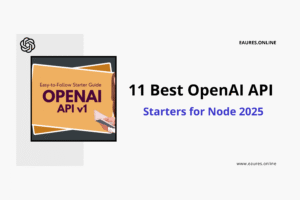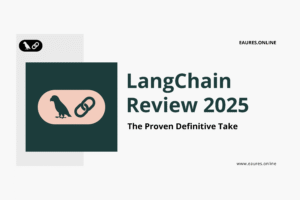Table of Contents
LangChain vs LlamaIndex: The Best Dev Guide for 2025
Why this guide and who it’s for
If you’re building retrieval-augmented generation (RAG), evaluators, or multi-tool agents, you’ve likely faced the LangChain vs LlamaIndex decision. Both are excellent, both ship fast, and both can carry a production workload—yet their design philosophies and ergonomics differ enough that the “best” choice depends on your architecture, your data pipeline, and your team’s mental model. This guide gives you a pragmatic, end-to-end comparison so you can choose with confidence.

Your expert guide to LangChain and LlamaIndex for smarter AI development
TL;DR
- Short projects & simple orchestration: LangChain feels familiar to Pythonistas who like composable “chains,” tools, and agents.
- Data-centric workflows & indexing: LlamaIndex shines where document parsing, node chunking, and retrieval customization dominate.
- RAG at scale: Both deliver; LlamaIndex offers very refined retrieval primitives, while LangChain offers broad ecosystem glue.
- Agents & tool use: LangChain’s agent/tooling catalog is huge; LlamaIndex’s agents are thoughtfully integrated with its data abstractions.
- Team fit: Choose the mental model your team can extend safely—framework ergonomics beat micro-benchmarks in long-run velocity.
What each framework is (and isn’t)
LangChain in one paragraph
LangChain is a modular toolkit focused on composable chains (prompt → model → parser → memory), tools/functions, and agents that reason over tools and data sources. It’s equal parts orchestration layer and batteries-included integrations, with strong support for function/tool calling and structured outputs. For fundamentals, the LangChain documentation explains chains, tools, agents, and integrations in depth within a consistent API surface.
LlamaIndex in one paragraph
LlamaIndex is a data-centric LLM framework organized around documents, nodes, indexes, and retrievers. It emphasizes ingestion, parsing, chunking, and retrieval strategies—making it natural for search-heavy RAG, hybrid retrieval, and graph-style indexes. The LlamaIndex documentation details how query engines, retrievers, and evaluators compose into a RAG system with clear boundaries.
LangChain vs LlamaIndex mental models
H2O vs. LEGO: what you’re really assembling
LangChain vs LlamaIndex often feels like operator-driven orchestration vs data-driven pipelines:
- LangChain: You assemble “LEGO” blocks of chains, tools, parsers, and memory into agents. The object model encourages branching logic and external tool use.
- LlamaIndex: You sculpt “H2O” around your corpus—documents → nodes → indexes → retrievers → query engines—then bind that to a model or agent. The data pipeline comes first.
Core primitives
- LangChain:
LLM,ChatModel,PromptTemplate,Runnable/chain,Tool,Agent, memory, output parsers. - LlamaIndex:
Document,Node,Index(vector, graph, list, tree),Retriever,QueryEngine,ServiceContext,Evaluator.
Where the philosophies converge
Both now support structured outputs, custom tools, function calling, async execution, and streaming. LangChain vs LlamaIndex is less about capabilities and more about what is idiomatic in each framework.
Your expert guide to LangChain and LlamaIndex for smarter AI development
RAG architecture: pipeline depth vs orchestration breadth
Data ingestion and parsing
LlamaIndex provides first-class building blocks for ingestion: loaders, node parsers, metadata extraction, and routing to indexes. If you anticipate frequent re-chunking, multi-granularity nodes, or multiple retrievers per corpus, LlamaIndex usually makes that path cleaner from day one. When you want to go from ingestion to production quickly with Python APIs and FAISS, start by reviewing a production-ready FastAPI FAISS RAG API to understand how ingestion, indexing, search, and generation line up inside a service boundary.
Retrieval strategy and hybrids
LlamaIndex’s retrievers make it natural to combine vector search with keyword/metadata filtering and reranking. LangChain supports the same ideas through retriever interfaces and community integrations; its strength is glue—pulling in your preferred vector DB, reranker, and rewriter as swappable parts.
Prompting & reasoning layer
With LangChain, composing guards (validation, parsers), rewriters, and tool-selection is very ergonomic. With LlamaIndex, constructing a QueryEngine that calls retrievers and synthesizers feels like SQL for LLMs: clear inputs, clear outputs, and a well-worn path for tracing.

Agents and tool use
Tool catalogs and patterns
LangChain leads with breadth: robust tool abstractions, a large catalog of integrations, and multiple agent patterns (react-style, tool-calling, plan-and-execute). If your application revolves around calling many external APIs, you’ll likely ship faster with LangChain’s agent ecosystem. For data-heavy agents that sit on top of curated indexes, LlamaIndex agents are tightly coupled to its retrieval fabric, which can reduce glue code.
Structured outputs and function calling
Both frameworks support function/tool calls and JSON outputs. In LangChain, structured parsing via output parsers (or schema-aware models) is idiomatic; in LlamaIndex, evaluators and response synthetizers integrate with retrieval steps so you can keep contracts clean between stages.
Your expert guide to LangChain and LlamaIndex for smarter AI development
Developer experience (DX)
Ergonomics and learning curve
- LangChain: If your team thinks in pipelines of operators, you’ll be productive quickly. “Chain of tools” fits well with SaaS integrations, automations, and custom evaluators.
- LlamaIndex: If your team thinks in data models and retrieval design, the document → node → index flow feels natural, and you get strong defaults for RAG.
Ecosystem and examples
LangChain’s breadth of examples is enormous and makes “productivity through composition” a reality. LlamaIndex’s examples skew toward RAG correctness, advanced chunking, and index engineering. For cross-team ideation, you can speed up discovery and strategy by reviewing curated AI prompts for product managers that translate stakeholder needs into concrete backlog items.
Performance, latency, and cost
Retrieval correctness vs speed
With LangChain vs LlamaIndex, retrieval accuracy often depends more on chunking, metadata hygiene, and reranking than on the orchestration layer. LlamaIndex’s node/metadata controls make it straightforward to experiment; LangChain’s plug-and-play retrievers and rerankers make it easy to swap implementations without refactoring.
Caching and batching
Both support response caching and batched calls where applicable. The bigger wins usually come from: (1) consolidated prompts, (2) fewer model hops, (3) cheaper model tiers for background phases, and (4) aggressive streaming to reduce perceived latency.
Vector choices and embeddings
Both frameworks can talk to FAISS, commercial vector DBs, and hybrid search. On CPU-only deployments, FAISS remains a great baseline for moderate corpora; for larger multi-tenant loads, managed services or GPU-enabled indices may pay off. Teams evaluating coding copilots alongside RAG often cross-reference the best AI code assistants in 2025 to align editor tooling with the server-side stack.
Evaluation and quality assurance
Offline evals
Both offer evaluators that measure relevance, faithfulness, and answer quality with LLM-as-a-judge methods. Treat these as relative metrics and pair them with human spot-checks—especially on edge cases and high-risk prompts.
Online evals and guardrails
Add canary prompts, live sampling, and PII/PHI redaction. Keep structured output validators close to your chains/query engines. For sales and customer-facing workflows, you can bootstrap messaging consistency with concise AI email prompts for sales outreach and feed real conversations back into your eval set.
Your expert guide to LangChain and LlamaIndex for smarter AI development
Security, privacy, and governance
Principle of least privilege
Scope credentials per environment and per tool. In multi-tool agents, isolate side-effects (databases, file I/O, admin operations) behind service facades with strict allow-lists.
Data residency and auditability
Favor providers and deployment modes that meet your residency, logging, and encryption needs. Build traceability from document ingestion through retrieval to final generations; both LangChain and LlamaIndex support tracing hooks so you can record which nodes/chunks led to an answer.
Productionization and MLOps
Deploying the service boundary
Whether you choose LangChain vs LlamaIndex, lock your service API early (sync/async endpoints, streaming, pagination, auth). Put the RAG or agent inside a container with a healthcheck and consistent logging. If you’re shipping a retrieval microservice, patterns from a FAISS RAG API with FastAPI and Docker generalize well to other vector DBs.
Observability and feedback
Track: latency per stage, token budget, retrieval hit rate, reranker score deltas, and user feedback signals. Use user-tagged “bad answers” as high-weight items in nightly evals.

Use-case-driven guidance
Rapid internal tools
For dashboards, back-office helpers, and one-off automations, LangChain’s tool/agent ecosystem accelerates delivery. You can get to a helpful MVP quickly and iterate.
Corpus-heavy knowledge bases
For research portals, policy hubs, and domain manuals, LlamaIndex typically wins on indexing and retrieval correctness thanks to node metadata, hybrid retrievers, and precise query engines.
Multi-source RAG with complex metadata
When you need granular control of chunking and filters—e.g., locale, version, department—LlamaIndex’s data model is compelling. LangChain can match this via integrations, but you’ll write more glue code.
Multi-tool agents for operations
For scheduling, ticketing, and workflow ops that call many APIs, LangChain’s agent patterns and tools are ergonomic and battle-tested. Pair agents with a small retrieval store for context and grounding.
Quickstarts: one file per framework
Minimal LangChain RAG
from langchain_openai import ChatOpenAI, OpenAIEmbeddings
from langchain.text_splitter import RecursiveCharacterTextSplitter
from langchain_community.vectorstores import FAISS
from langchain.prompts import ChatPromptTemplate
from langchain.schema.runnable import RunnablePassthrough
# 1) Ingest
docs = ["Your internal handbook text ..."]
splitter = RecursiveCharacterTextSplitter(chunk_size=800, chunk_overlap=100)
chunks = splitter.create_documents(docs)
# 2) Index
emb = OpenAIEmbeddings()
store = FAISS.from_documents(chunks, emb)
retriever = store.as_retriever(search_kwargs={"k": 4})
# 3) Chain (retrieve → prompt → model)
template = """Use ONLY the context to answer.
Context: {context}
Question: {question}
Answer:"""
prompt = ChatPromptTemplate.from_template(template)
llm = ChatOpenAI(model="gpt-4o-mini", temperature=0)
chain = (
{"context": retriever, "question": RunnablePassthrough()}
| prompt
| llm
)
print(chain.invoke("What is our PTO policy?"))
Minimal LlamaIndex RAG
from llama_index.core import VectorStoreIndex, Document
from llama_index.embeddings.openai import OpenAIEmbedding
from llama_index.llms.openai import OpenAI
# 1) Ingest
docs = [Document(text="Your internal handbook text ...")]
# 2) Index
embed_model = OpenAIEmbedding()
index = VectorStoreIndex.from_documents(docs, embed_model=embed_model)
# 3) Query engine (retrieve → synthesize)
llm = OpenAI(model="gpt-4o-mini", temperature=0)
query_engine = index.as_query_engine(similarity_top_k=4, llm=llm)
print(query_engine.query("What is our PTO policy?"))
These minimal examples illustrate how LangChain vs LlamaIndex express the same RAG steps with different primitives.
Migration: moving between frameworks safely
From LangChain to LlamaIndex
- Map your documents and metadata to nodes; preserve provenance.
- Recreate retrievers (BM25, vector, hybrid) and carry over rerankers.
- Re-evaluate chunk size/overlap; LlamaIndex often benefits from smaller, metadata-rich nodes.
From LlamaIndex to LangChain
- Recreate index/retriever via LangChain integrations; expose as a
Retriever. - Port prompt templates and output parsers; keep tool contracts identical.
- If you used many external APIs, consider LangChain Agents for clarity and reuse.
Decision checklist (print this)
- Do we think in operators (chains, tools) or data (nodes, indexes)?
- Is our main risk retrieval correctness or tool orchestration?
- Who owns the pipeline—search engineers or backend integrators?
- Will we need many external APIs or primarily document-grounded answers?
- Which framework’s examples best match our domain today?
If you answer “operators/tools/APIs” to most, lean LangChain. If you answer “data/indexing/retrieval” to most, lean LlamaIndex.
Common pitfalls and how to avoid them
- Over-chunking: Bigger isn’t better; tune chunk size/overlap to preserve semantics.
- Under-annotated nodes: Put structured metadata on nodes early; it pays dividends in relevance.
- Prompt sprawl: Centralize prompts; parameterize role, tone, and format.
- Unbounded tools: In agents, fence dangerous side-effects, implement dry-run modes, and log tool I/O.
- No ground-truth evals: Mix LLM-judged metrics with curated human-labeled checks. Even a dozen scenarios from real tickets or emails can surface failure modes rapidly.
For hands-on inspiration beyond RAG, compare trade-offs across assistants by reviewing hands-on benchmarks and pricing for AI code assistants and align editor/CLI ergonomics with your service APIs.
When both frameworks are right
Plenty of teams deploy LangChain vs LlamaIndex together: e.g., use LlamaIndex for ingestion/retrieval and LangChain for agents/tools and structured outputs. The seam is your retriever interface and the contract of your service boundary. As long as you keep observability and test fixtures consistent, dual-stack is entirely reasonable.

Final recommendation
- If your product revolves around tooling and external APIs, or you want maximal composition of chains and agents, choose LangChain.
- If your product revolves around document intelligence, precise retrieval design, and index engineering, choose LlamaIndex.
- If you need both, don’t hesitate to compose them: they interoperate well, and the seam is testable.
For a deeper backend implementation path, study an end-to-end RAG API with FastAPI and FAISS to see how ingestion, indexing, retrieval, and generation become a single, testable service. That same pattern is extensible to both frameworks.
References worth bookmarking
- Learn primitives and patterns in the LangChain documentation to master chains, tools, and agents.
- Explore ingestion, nodes, and query engines in the LlamaIndex documentation for data-centric RAG.
- For structured tool calling, review the OpenAI function/tool calling docs to tighten schemas and outputs.
- Study FAISS concepts in the FAISS repository documentation to reason about index choice, memory, and recall.




